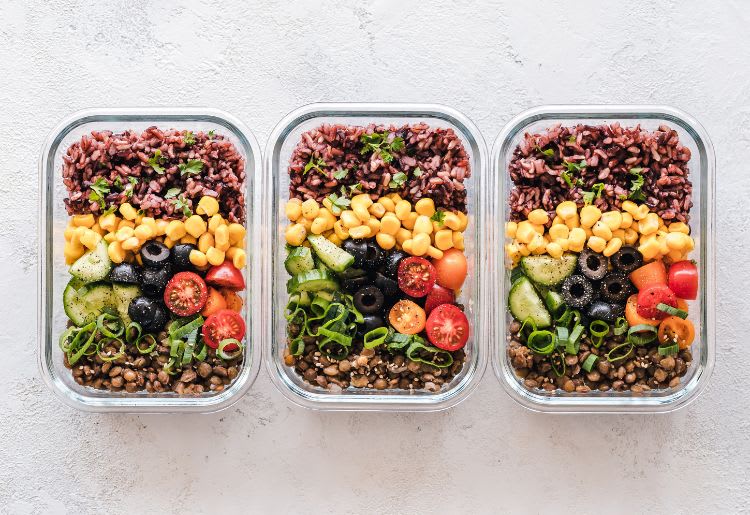While weight loss fads usually help people lose weight quickly in the short term, this article will dive deep into the top 10 diet plans that are here to stay.
1. Keto Diet
The keto diet is currently one of the most popular new diets, but it’s actually been around since the 1920s - initially used as a treatment for epilepsy. It recently regained popularity because celebrities started using it for weight loss.
Keto is an entirely low-carb, high-fat diet. The goal is to consume between 20-50 grams of carbs to enter a metabolic state called ketosis. Ketosis is a metabolic state in which the body burns fat for energy instead of carbohydrates. Without carbs, the body turns to stored fat for energy.
Keto diets usually result in rapid weight loss, among other things. A 2013 study found it was more effective for weight loss and improving blood lipids than a calorie-controlled, low-fat diet. The main criticism of the keto diet is that it is hard to stick with long-term. Once you reintroduce carbohydrates, the extra weight may come back.

2. Atkins Diet
The Atkins Diet is a low-carb, high-protein diet created in the 1970s. It is a weight-loss diet that aims to induce ketosis, a metabolic state where the body burns fat for fuel instead of carbohydrates. The diet was updated in 2003 to include lean protein, healthy carbs, and unsaturated fats.
The diet starts with a restrictive low-carb phase. It gradually increases the number of carbs you can have while eliminating refined flour and sugar. Eventually, you reach a maintenance phase, a period of dieting after getting your desired weight, where you work to maintain weight loss and prevent weight gain. It involves adjusting your eating habits to a balanced caloric intake that helps you maintain weight while allowing for flexibility.
Low carbohydrate diets are effective for weight loss. In a study comparing Atkins dieters to other popular diets, researchers found that those on Atkins lost significantly more weight than subjects following the other diets.
Atkins may be great for fast weight loss but may result in weight regain with reintroduced carbs.
3. South Beach Diet
The South Beach Diet is a low-carbohydrate, high-protein diet in the early 2000s. The diet splits into phases: a short, restrictive induction phase, followed by a longer, more relaxed phase of gradual reintroduction of certain foods.
The maintenance phase of the South Beach Diet is a healthy eating plan that allows for a few treats. Maintenance involves eating a balanced diet of lean proteins, low glycemic carbohydrates, unsaturated fats, and plenty of vegetables.
The South Beach Diet principles are based on solid science: Higher protein, lower carbohydrate diets increase satiety and help with weight loss. However, it’s important to note that there has been one case study of a person following the South Beach diet that developed ketoacidosis, a condition when your body doesn’t have enough insulin.
4. Weight Watchers
Weight Watchers has been around for ages. The program is based on eating a calorie-restricted diet and tracking the “points” (value) of foods.
Recently, the brand has focused more on choosing whole foods, like vegetables and lean proteins, which are now considered ZeroPoint foods on the program. A critical aspect of the Weight Watchers diet is the accountability aspect via support group meetings and regular weigh-ins.

If you stick with the program, Weight Watchers works. A review of 39 clinical trials found that people lose approximately 2.9% more weight on Weight Watchers than on other diet programs. Another study found that participants who followed the program for at least a year were more successful at maintaining their weight over two years.
5. Zone Diet
The Zone Diet is a celebrity-popularized diet that encourages balancing macronutrients at each meal. Macronutrients are the three primary nutrients that provide energy (calories) to the body: carbohydrates, proteins, and fats. The goal of the Zone Diet is to eat 40% of calories from carbs, 30% from fat, and 30% from protein. You should be able to control your insulin levels and reset your metabolism and hunger to induce weight loss.
There is little evidence to support the claims about the optimal macronutrient distribution of the Zone Diet. Eating a balanced diet is ultimately beneficial for many dieters seeking long-term solutions.
6. Nutrisystem
Nutrisystem is a diet plan that involves eating prepared meals shipped to your home. This service eliminates any planning and thinking required for dieting, as meals meet your unique caloric requirements. The meals also keep in mind the glycemic index of foods, meaning how fast sugar will get into your blood, helping regulate blood sugar.
Removing decision fatigue around what to eat and pushing dieters towards healthy choices can be helpful for some people in losing weight. But, only being able to consume food from a box can become boring.
In terms of research, one study found that people lose around 15-25% of their body weight while following the program, but weight regain is common once they stop eating the boxed food.
7. Macrobiotic Diet
The macrobiotic diet is more of a lifestyle than a diet, as it is based on the principle of yin and yang. All foods have an energy that can promote or harm health and balance. So, the macrobiotic diet is filled with whole grains, beans and legumes, vegetables, fermented foods, and fish while avoiding meat.
The macrobiotic diet’s focus on unprocessed foods and slowing down while eating may help you naturally achieve a healthier weight. This food plan has plenty of benefits: the diet has been evaluated for possibly helping prevent cardiovascular disease and cancer due to its focus on plant-based foods and minimal animal fat. The main concern with the macrobiotic diet is that it may be hard to stick with due to the restrictions of how foods need to be prepared and the lifestyle changes involved.

8. Carb Cycling
Carb cycling is a slightly easier approach to following a low-carb diet. The diet plan alternates high-carb consumption periods with low-carb consumption periods. This diet is popular with fitness gurus who use it to achieve specific body goals and cut fat.
There is little scientific evidence to support the effectiveness of this trendy diet. A few studies exist from the 1990s on the impact of carb cycling on weight training and exercise performance. It may also influence hunger and satiety hormones, like leptin, making it easier to stick with a low-calorie diet. In general, carb cycling should be done under the guidance of a healthcare professional or registered dietitian to ensure that you meet nutritional needs and minimize potential health risks.
9. Paleo and Whole 30 Diets
The Paleo (short for Paleolithic) Diet, also known as the Caveman Diet, is based on the idea of eating as our ancestors did during the Paleolithic era, before the creation of modern processed foods. The goal of the diet is to eat a nutrient-dense, balanced diet that is high in fiber, protein, and healthy fats and low in carbohydrates and added sugars.
Whole 30 is a spin-off of the Paleo Diet. It involves following a stricter version of Paleo, eliminating certain natural foods, such as potatoes and corn, for 30 days to help identify any food sensitivities and intolerances, reduce inflammation in the body, and improve overall health and well-being.
Despite the popularity of the Paleo diet, there is little evidence to support its claims. One of the main criticisms is that the diets of cavemen are highly disputed. While we can probably assume they didn’t exist on a diet of chips and sodas, a true paleolithic diet likely varied depending on the region.
10. Volumetrics Diet
Volumetrics aims to help people eat fewer calories while still feeling full and satisfied, promoting gradual weight loss and long-term weight management. The diet focuses on controlling portion sizes and energy density (calories per gram) of foods rather than counting calories or limiting certain food groups. The focus is on consuming foods high in fiber and water, allowing you to eat larger volumes of food while controlling calories.
The foods highest in water and fiber are primarily fruits and vegetables. A diet rich in plants has been shown to help with weight loss.
Choosing the Best Diet for You
The truth is that following a trendy diet ignores your lifestyle, personal preferences, and needs. Additionally, rigidly following any of these diets may likely lead to unnecessary excessive restrictions.
When choosing how to eat, pick a weight loss method that is sustainable long-term. Eating food from a box or trying to eliminate all carbohydrates forever will likely only result in weight regain. A healthy weight gets built on a simple foundation of a plant-rich diet supplemented with healthy fats and lean protein. Keeping it simple is the most effective way to reach your goals, rather than jumping from fad to fad.
